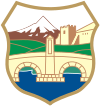Stone Bridge (Skopje)
Stone Bridge Камен Мост | |
|---|---|
 | |
| Coordinates | 41°59′49″N 21°25′59″E / 41.996992°N 21.433071°E |
| Crosses | Vardar River |
| Locale | Skopje |
| Characteristics | |
| Design | arch bridge |
| Total length | 214 m |
| Width | 6 m |
| Location | |
 | |
The Stone Bridge (Macedonian: ,Turkish: Taşköprü) is a bridge across the Vardar River in Skopje, the capital of the Republic of Macedonia. The bridge is considered a symbol of Skopje and is the main element of the coat of arms of the city, which in turn is incorporated in the city's flag.[1] The Stone Bridge connects Macedonia Square, in the center of Skopje, to the Old Bazaar.[2] The bridge is also less frequently known as the Dušan Bridge after Stephen Uroš IV Dušan of Serbia.[3]
Architecture

The Stone Bridge is built of solid stone blocks and is supported by firm columns that are connected with 12 semicircular arcs. The bridge is 214 m (702 ft) long and 6 m (20 ft) wide. The guardhouse has recently been reconstructed.[4]
History
The current Stone Bridge was built on Roman foundations under the patronage of Sultan Mehmed II the Conqueror between 1451 and 1469.[5][6][7] Throughout the centuries, the Stone Bridge was often damaged and then repaired. There is historical evidence that it once suffered during the great earthquake of 1555 which heavily damaged or destroyed four pillars. Renovations were carried out the same year. In 1944, explosives were placed on the bridge by Nazis. When Skopje was liberated, the activation of the explosives was prevented and the bridge was saved from destruction. The last reconstruction of the bridge began in 1994. The watchtower shaped like a mihrab was reconstructed in 2008.
Some executions have also taken place on this bridge, such as the execution of Karposh in 1689.
Gallery
-
Stone Bridge and Macedonia Square in the early 1920s
-
Stone Bridge in 1909
-
Inscription on the bridge
-
Stone Bridge at night
-
Memorial plaque on the site of Karposh's execution
-
View from the top
-
Lateral view
-
Stone Bridge, photo from the 1950s
See also
References
- ^ Official portal of the city of Skopje: City symbols. – Retrieved on 13 May 2009.
- ^ Stone bridge, Skopje, Macedonia
- ^ Knowledge Bank at OSU
- ^ Kameniot Most na Vardar, Skopje
- ^ Macedonia, Bradt Travel Guid, Thammy Evans, Bradt Travel Guides, 2010, ISBN 1841622974, p. 139.
- ^ Skopje In Your Pocket 2006-2007, Sco, Jeroen van Marle, In Your Pocket, p. 27.
- ^ Macedonia, Jovan Popovski, Turistička štampa, 1969, p. 66.








